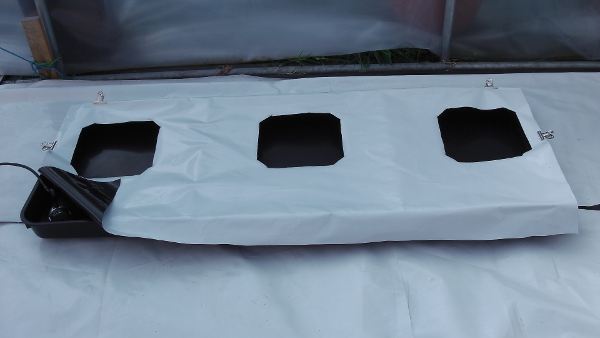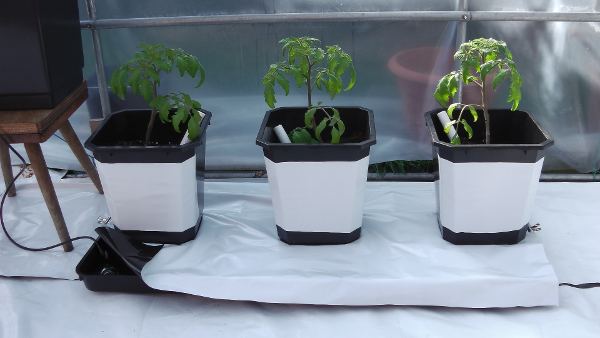It’s been a good week for me because I spent it in Devon. I took four of the sow-along seedlings with me just in case the watering system for tomatoes didn’t work – I’m glad I did!
I returned home to find the tomato seedlings in the auto watering trays have been over watered and have become a bit leggy. This happens when seedlings and young plants receive too much water and too little light.
Never mind, I shall trench the leggy ones when I plant them in their final position.
It’s always easier to water large plants in large pots than watering seedlings in smaller pots when it comes to auto watering systems.
Smart valves – for final position watering
This week I would like to show you one way of watering plants in trays using the smart valve.
One of the disadvantages with open trays is the algae growth and other unwanted items that appear when water is exposed to light.

The string keeps the plastic cover raised and clips are used to keep the cover in position.

The plastic is white on one side and black the other. Ideal for this job and available online from most hydroponic shops.

The smart valve is fed by a water tank. Nutrients can be added to the tank when the food in the soil is used-up by the plants.
The above set-up is a DIY option to the autopot system and less expensive. A larger tray would hold more plants and make it better value for money too.
The Thin Line
Some people are reluctant to share their knowledge and keep it to themselves.
This may be because they wish to keep it a secret, sell it on the internet or worry that people may follow it and have a disaster!
I probably fall into the last category and worry that if I mention that tomato plants can cope with low temperatures, people may leave their seedlings out all night in the frost and lose them.
The thing is, after many years of experimenting, disasters and some successes, you get to know a few things that can only be shared when understood “in context”.
One of these is … although tomato plants won’t grow below around 10C, some varieties will easily survive down to a frost and pick up again when the temperatures rise above 10C.
This isn’t something that I regularly talk about because a slight miss-reading of this will have me stating that it’s ok to leave your tomato plants out in the frost!
The reason I mention this is partly because temperatures around 5C are nothing to be concerned about as long as other growing conditions are good.
Condensation and wet leaves
What is a concern, especially at this time of the season, is condensation and wet leaves!
In March, I replaced the cover on the polytunnel but decided to have an open front. This allows greater air circulation and I would much rather have slightly lower temperatures than condensation and wet leaves.
More on this next week.

Sometimes you just got to take them with you!
Regards,
Nick
PS
De-leafing is the removal of lower leaves that are diseased or no longer of benefit to the well-being of a plant.
Traditionally, it is common to remove leaves up to the truss that is ripening. So when the tomatoes on the first truss begins to ripen, the leaves below can be removed and so on.
The health of a tomato plant is usually displayed in its leaves. Mineral deficiencies, fungal diseases and viruses are usually shown in leaves so it’s good to keep an eye open for changes in leaf colour etc.


Robert Green
Hi Nick
Totally agree with your comments about ventilation vs heat. I think many of us (me included) have a paranoia that we must keep all doors and windows of growing houses shut to keep warmth in. To the detriment of condensation!
Keep up the good work.
Had a few issues with mobile site btw via Android device. Can’t access newsletters other than the first one but desktop version is fine.
Robert
Nick
Thanks Robert … I’ll look in to it!
Nick
Rhys Jaggar
Nick
To let you know that that RootIt First Growth you sent me worked an absolute treat on my sickly seedlings – they are now back to normal and brimming with health. Great product!!
Also had great experiences with MaxiCrop Concentrated Seaweed Extract in the period 5 weeks to 10 weeks after germination – really, really rapid growth after using a quite dilute dosage.
Just about to sow my final seeds of the season – a batch of Red Alerts to provide later-season cherries.
May is about to arrive with frosts and air from the arctic!!
What a weird year we are having…….
andy
https://www.facebook.com/groups/144745362329424/
hi nick and all.been doing a lot,quite a lot actually (lol) of trawling the net for ideas,tips and the like for the past week and found the above facebook group very interesting.going to give 2 of the methods of theirs a try on a small scale and see how it goes.also linked to this group on you tube some realy interesting video how to’s by a guy called larry hall.
jess allaway
Hi Nick, very useful info as usual! This year I think I’ll give the air pots a try – like to experiment with something new each year if I can for a couple of plants at least. I think you mentioned a good place to buy those in an earlier newsletter. Checking on the internet is fine pricewise but don’t know what quality to expect! Can you recommend a supplier? All my seedlings seem to be growing very slowly this year so maybe it’s the quite low temperatures we’ve been having at night. Then again, maybe I’m watching them too much – think boiling kettle! Could be they just need a holiday in the sun!! Best regards, Jess.
alan hall
Thanks Nick for this article, where can we buy the smart valves you mention and what about the header tank that you can fill with nutrient/water mix.
Have a good weekend
kind regards
Alan
John Bowtell
We are off on a caravanning holiday soon, large enough to take my eighty tomato seedlings with us but I think my wife would complain. I just get a daughter to water.
Great newsletter. Thanks.
John